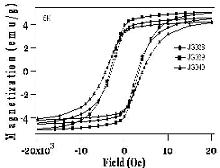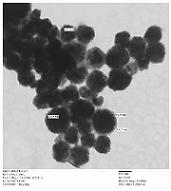
ACS PRF | ACS
All e-Annual Reports

43058-B10
Ferro-Antiferromagnetic Exchange Coupled Nanocomposites
Exchanged coupled nanocomposites
The overall research goal of this grant is to better understand the magnetic properties of exchange coupled nanoparticles with a vision to enhance their magnetic properties. The main objectives of this research project are to: (1) Explore synthesis technique to grow antiferromagnetic coating layer on ferromagnetic core particles to form exchange coupled magnetic nanocomposite, (2) better understand the magnetic properties of these materials, and (3) involve undergraduate students in research in the field of magnetic nanomaterials.
To date students have synthesized CoFe2O4-Fe3O4 exchange coupled magnetic nanocomposites using hydrothermal technique. During the synthesis process, growth of AFM layer was monitored using XRD, ESEM, and TEM and thermal stability was studied using DSC, DTA and TGA (Figure 1). The feedback provided from these results helped us to tweak the synthesis process. Students are getting excellent learning experience in using various analytical tools such as XRD, SEM, TEM, and DSC. The detail studies on temperature dependent XRD on the synthesis of CoFe2O4-Fe3O4 composite was reported earlier.
Upon initial characterization of these nanocomposites, students have prepared several nanocomposites with varying mole ratio Fe/Co :0.27, 0.40,0.53, and 0.80 with an intention to vary the thickness of CoFe2O4 layer.
Detailed temperature dependent hysteresis loops for the nanocomposite with Fe/Co molar ratio of 0.40 is presented in the figure 2 and 5K magnetization loops for samples with varying Fe/Co molar ratio is presented in Figure 3. It was found that the coercivity of samples increased with the decrease in the Fe/Co molar ratio. In the related project students are also preparing FeNi-MnO and carbon coated core-shell nanocomposites using hydrothermal technique, Figure 4. During the year 2007-2008 two undergraduate students completed their senior research projects under this grant. The research projects motivated and encouraged one undergraduate to pursue MS program in Physics at the UoM and one at the UT of Arlington. Students also participated in presenting their work at the Work-in-Progress competition at the UoM and NCUR at Dominican University, CA
|
|
Figure 1a: DTA curves of CoFe2O4-Fe3O4 with different Fe/Co mole concentration.
| Figure 2: Temperature dependent magnetization curves at 5, 15, 30, 40, 50, 100, 200, and 300K
|
|
|
Figure 3: Figure 3: 5K magnetic hysteresis loops of samples with different Fe/Co molar ratios.
| Figure 4: FeNi nanoparticles coated with amorphous carbon synthesized using “
|



